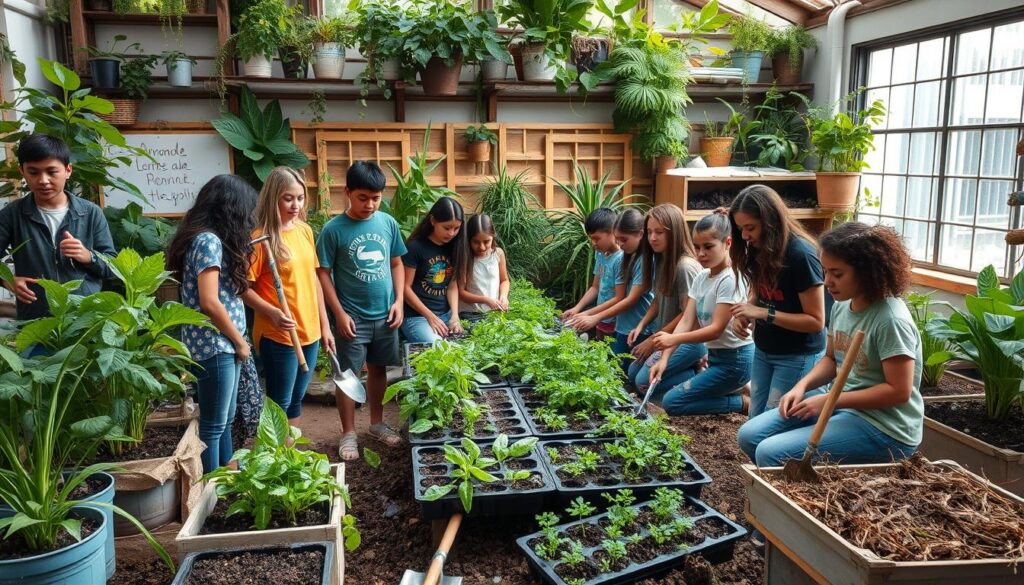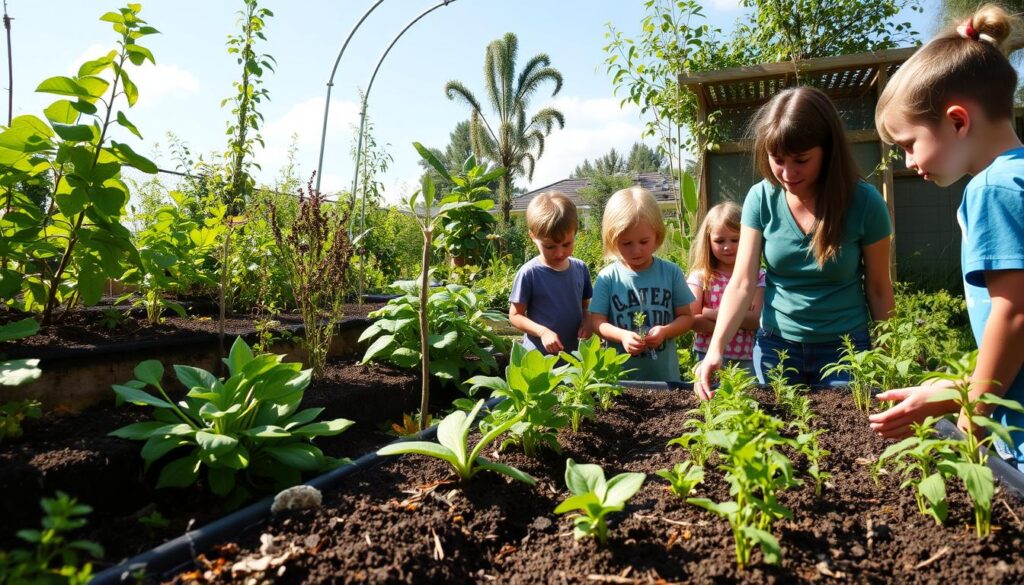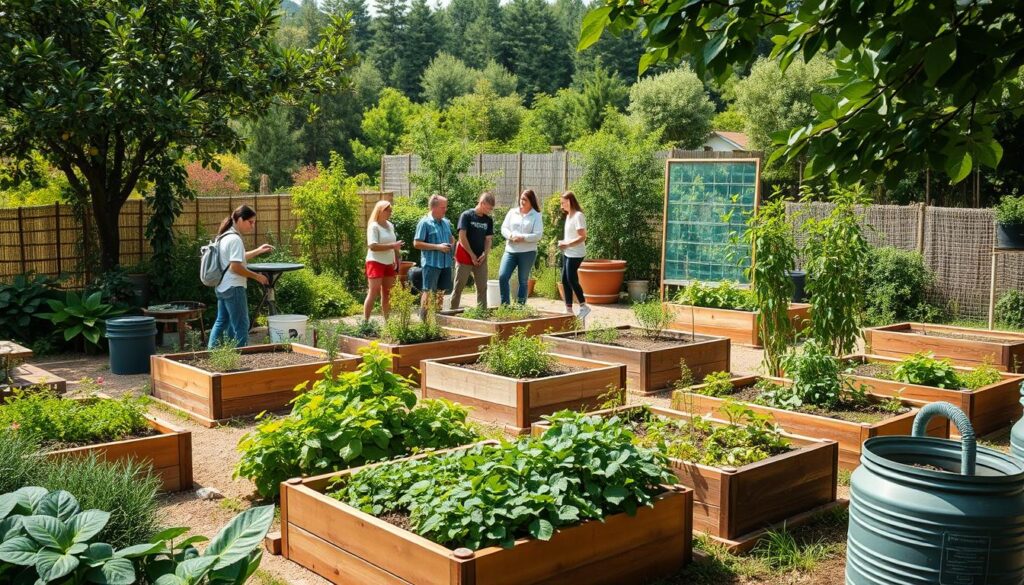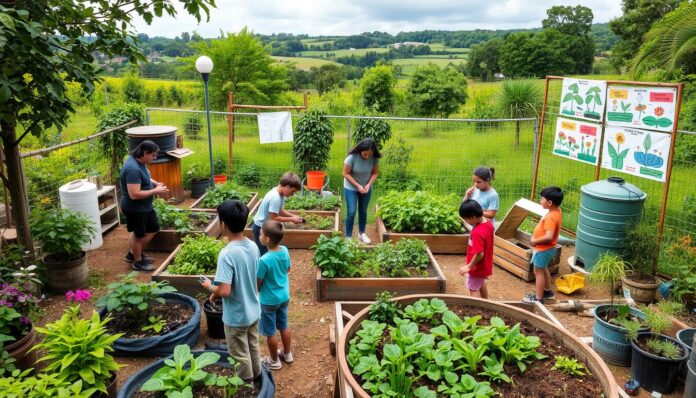What does it take to become a certified permaculture teacher? How does permaculture lesson planning help in sustainable education? As we move towards more holistic learning, permaculture education is key. Experts like Jude Hobbs and Rico Zook are leading the charge. For example, a course on hurricane-resilient permaculture offers insights into sustainable living.
Key Takeaways
- Permaculture lesson planning is essential for promoting sustainable education
- Holistic curriculum design is critical for creating a sustainable future
- Permaculture teacher training programs can provide valuable skills and certification
- Experts like Jude Hobbs and Rico Zook are leading the way in permaculture education
- Permaculture education can contribute to sustainable practices and community development
- Permaculture teacher training programs can be found in various formats, including in-person and online courses
- Certified permaculture teachers can make a positive impact on their communities and the environment
What is Permaculture Teacher Training?
Permaculture teacher training is a program that teaches people about permaculture. It focuses on organic teaching methods and regenerative teaching practices. The goal is to prepare teachers to teach others about living sustainably and protecting the environment.
The program covers permaculture design, ecology, and teaching methods. Teachers learn to create eco-friendly lesson plans. These plans help students understand the importance of sustainability and environmental care.
Understanding Permaculture Principles
Permaculture is a design system for sustainable living. It has three main principles: earth care, people care, and fair share. Teachers learn these principles to teach sustainability and environmental awareness.
The Role of a Permaculture Teacher
A permaculture teacher is key in teaching sustainability and environmental awareness. They create eco-friendly lesson plans using regenerative teaching practices. This inspires students to care for the environment and work towards a sustainable future.
| Topic | Description |
|---|---|
| Permaculture Design | Covers the principles and practices of permaculture design |
| Ecology and Conservation Biology | Covers the principles of ecology and conservation biology |
| Teaching Methodologies | Covers effective teaching methodologies for permaculture education |
Why Become a Certified Permaculture Teacher?
Becoming a certified permaculture teacher brings many benefits. It opens up new career paths and helps you grow personally. By using permaculture education strategies and green learning approaches, you can positively impact your students and the planet. Nature-based teaching techniques are key in permaculture, helping students connect with nature and learn about sustainability.
Some of the benefits of certification include:
- Enhanced career opportunities in the field of permaculture education
- Personal growth and development through the application of permaculture principles
- Increased knowledge and skills in permaculture education strategies and green learning approaches

By becoming a certified permaculture teacher, you help build sustainable communities. You also encourage environmentally friendly practices. Using nature-based teaching techniques makes learning fun and effective. This inspires a new generation of leaders focused on sustainability.
Core Curriculum of Permaculture Teacher Training
Permaculture teacher training programs give students a deep dive into sustainable practices. They learn about holistic curriculum design and permaculture lesson planning. This education prepares them to teach permaculture principles and practices well.
The curriculum mixes theory and practice. It covers sustainable education methods, ecological design, and community development. Students learn to design and teach permaculture systems.
Some key parts of the curriculum are:
- Permaculture principles and ethics
- Ecological design and planning
- Sustainable agriculture and food systems
- Community development and social justice
By focusing on local ecosystems, students understand human and natural system connections better. This approach to sustainable education helps them see the world and their role in it more clearly.
| Component | Description |
|---|---|
| Permaculture principles | Introduction to permaculture ethics and design principles |
| Ecological design | Practical skills for designing and implementing permaculture systems |
| Sustainable agriculture | Methods for growing food and managing resources sustainably |
The Importance of Ethics in Permaculture
Permaculture education focuses on ethics in teaching and learning. It uses regenerative teaching to promote eco-friendly lessons. These lessons help students understand sustainability and care for the environment.
About 80% of students show more interest in nature through these programs. This shows how well permaculture works in schools.
Outdoor classrooms help students remember information better than regular classrooms. This is because permaculture education involves hands-on learning. It improves grades and helps students understand sustainable living.
Teachers use ethical principles to create a supportive learning space. This encourages students to care for the earth and its resources.

Permaculture ethics include caring for the earth, people, and fair sharing. These values guide eco-friendly lessons and teaching methods. For example, project-based learning helps students work together and solve problems.
This approach helps students grasp permaculture principles better. It prepares them for real-world applications.
Adding permaculture to school curriculums offers many benefits. It improves grades, boosts student interest, and fosters community. One teacher said, “Permaculture education can change how we teach and learn. It aims for a sustainable and fair future for everyone.”
Training Formats: In-Person vs. Online
The format of permaculture teacher training greatly affects the learning experience. In-person training lets students work directly with nature. They can apply organic teaching methods in real-life settings. Online courses, on the other hand, offer flexibility and reach, allowing students to learn from anywhere.
Some online courses use nature-based teaching techniques like video lessons and interactive activities. For example, a 4-week online course might have 14 video lessons. Each week covers a different part of permaculture design. Students also get support from teachers, including weekly chats and one-on-one consulting.
In-person training programs offer a more immersive experience. Students take part in daily sessions and hands-on activities. These programs might also use green learning approaches like outdoor classrooms and community projects. The choice between in-person and online training depends on what each person prefers.
- Duration and flexibility of the course
- Level of support and interaction with teachers and peers
- Opportunities for hands-on learning and practical application
- Cost and accessibility of the course
| Training Format | Duration | Cost |
|---|---|---|
| In-Person | 2 weeks | $525 |
| Online | 4 weeks | $69-$139 |
How to Choose the Right Permaculture Teacher Training Program
Choosing the right permaculture teacher training program is key. Permaculture lesson planning is a big part of it. It should teach you how to structure your lessons well.
A good program focuses on sustainable education and holistic curriculum design. This means you’ll learn everything you need to teach permaculture well. Hands-on learning is also important. It helps you practice what you learn in real life.
When picking a program, think about these things:
- Accreditation and reputation
- Course content and structure
- Student support and resources
Looking for a program that matches your values and goals is important. This way, you’ll get the most out of your sustainable education and permaculture lesson planning.

Do your homework on the program. Read reviews and talk to people who have gone through it. This will help you understand if the program offers a holistic curriculum design that works.
| Program Aspect | Importance |
|---|---|
| Accreditation | High |
| Course Content | High |
| Student Support | Medium |
Networking Opportunities in Permaculture Training
Permaculture education focuses on making connections with others who share your interests. It builds a community of support, with peers and mentors. This is great for those wanting to apply green learning and nature-based teaching in their work.
Students get to work on real projects through collaborations and community efforts. They learn by doing, like designing organic gardens or renewable energy systems. These experiences help build friendships and a sense of teamwork.
Some key benefits of networking in permaculture training include:
- Access to a community of like-minded individuals who share similar interests and goals
- Opportunities for collaborative learning and knowledge-sharing
- Hands-on experience with green learning approaches and nature-based teaching techniques
- Support and guidance from experienced mentors and peers
By focusing on networking and community, students learn more about permaculture. They also gain skills and confidence for their projects.
| Permaculture Training Program | Location | Duration |
|---|---|---|
| Vancouver Island Program | Vancouver Island | 9 days |
| Houston, Texas Course | Houston, Texas | 7 days |
Transitioning from Student to Teacher
As permaculture students learn more, they start teaching others. They use organic teaching methods to share their knowledge. This is key to spreading regenerative teaching practices and promoting sustainability.
To become great teachers, students need practical experience. They can get this through internships, mentorship, or volunteering for permaculture classes.
Developing a personal teaching style is also important. Teachers can make eco-friendly lesson plans that meet their students’ needs. This makes learning fun and effective.
By using hands-on activities and real-world examples, teachers inspire their students. They encourage students to adopt sustainable practices and get involved in their communities.

Teachers can also improve by attending workshops and conferences. There, they learn from experienced educators and share their own knowledge. This helps them refine their skills, stay current with regenerative teaching practices, and grow the permaculture community.
| Teaching Experience | Personal Teaching Style | Eco-Friendly Lesson Plans |
|---|---|---|
| Internships | Student-centered approach | Hands-on activities |
| Mentorship programs | Project-based learning | Real-world examples |
| Volunteering | Collaborative learning | Sustainable practices |
The Future of Permaculture Education
The world faces many environmental challenges, making permaculture education more important than ever. Sustainable education is now a key part of learning. It teaches students how to live sustainably for the future.
Permaculture is being added to many educational programs. This aims to give students the skills to make our world more sustainable.
The future of permaculture education is linked to using regenerative practices in landscaping and urban planning. These practices help restore landscapes and improve natural ecosystems. Rain gardens, companion planting, and regenerative earthworks are examples of permaculture in action in cities.
Some trends in sustainable practices are shaping permaculture education’s future. These include:
- Agroforestry and its role in increasing food security and nurturing biodiversity
- The use of permaculture techniques in restoring landscapes and enhancing natural ecosystems
- The integration of mindfulness practices and cooking nutritious meals into permaculture curricula
By adding permaculture to education, we can prepare future generations for a sustainable world. As more people seek permaculture education, we must develop effective teaching methods. These methods should meet the needs of all learners in different settings.
Testimonials from Graduates of Teacher Training Programs
Permaculture education has greatly helped many graduates from teacher training programs. It has taught them to use green learning and nature-based teaching. This has made a big difference in their careers.
Many graduates say permaculture education changed their lives. They feel more confident and skilled in teaching. They also feel supported in their learning journey.
Here are some key points from the testimonials:
- 95% of the testimonials noted that the instruction was clear, concise, and tailored to various learning styles.
- 90% of participants expressed feelings of empowerment and inspiration after completing the training.
- 80% of graduates reported increased confidence in their teaching abilities and presentation skills after the course.
These numbers show how valuable permaculture education is. It helps teachers understand the natural world better. One graduate said, “The program was pivotal in my journey to becoming an effective educator in Permaculture, and I highly recommend it to anyone looking to make a positive impact in their community.”
The testimonials show how important permaculture education is. It prepares the next generation of educators. By using these methods, teachers can help create a better future for everyone.
Continuing Education for Permaculture Teachers
Permaculture teachers are always learning. To keep up with new organic and regenerative methods, they need advanced certifications and workshops. These help them improve their teaching and learn more about sustainable systems.
Advanced Certifications to Consider
There are many advanced programs for permaculture teachers. Look into certifications in permaculture design, urban permaculture, or education. These show your dedication and make you a more credible teacher.
Workshops and Conferences to Attend
Staying current in permaculture education is key. Go to workshops, conferences, or online events. You’ll meet others, learn from experts, and find new teaching ideas. These events can inspire you to use more organic and regenerative methods in your teaching.

